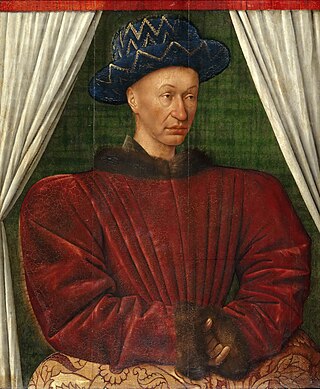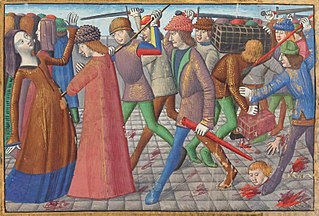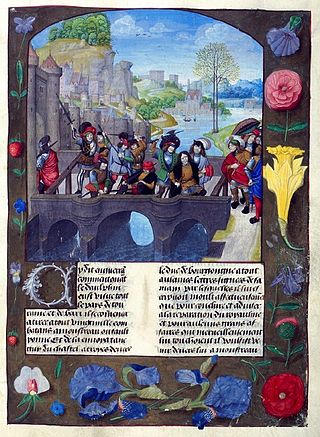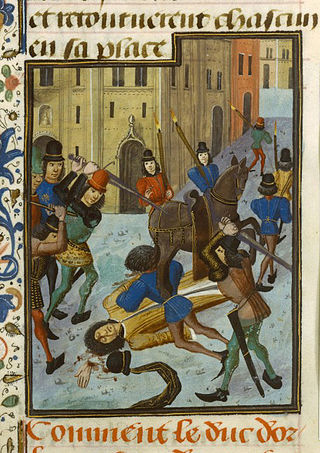
Year 1413 (MCDXIII) was a common year starting on Sunday of the Julian calendar.

Charles VII, called the Victorious or the Well-Served, was King of France from 1422 to his death in 1461. His reign saw the end of the Hundred Years' War and a de facto end of the English claims to the French throne.

Charles VI, nicknamed the Beloved and in the 19th century, the Mad, was King of France from 1380 until his death in 1422. He is known for his mental illness and psychotic episodes that plagued him throughout his life.
The Treaty of Troyes was an agreement that King Henry V of England and his heirs would inherit the French throne upon the death of King Charles VI of France. It was formally signed in the French city of Troyes on 21 May 1420 in the aftermath of Henry's successful military campaign in France. It forms a part of the backdrop of the latter phase of the Hundred Years' War finally won by the French at the Battle of Castillon in 1453, and in which various English kings tried to establish their claims to the French throne.

Pierre Cauchon was a French Catholic prelate who served as Bishop of Beauvais from 1420 to 1432. He was a strong partisan of English interests in France during the latter years of the Hundred Years' War. He was the judge in the trial of Joan of Arc and played a key role in her execution. The Catholic Church overturned his verdict in 1456.

John I was a scion of the French royal family who ruled the Burgundian State from 1404 until his assassination in 1419. He played a key role in French national affairs during the early 15th century, particularly in his struggle to remove the mentally ill King Charles VI and during the Hundred Years' War against Kingdom of England. A rash, ruthless and unscrupulous politician, John murdered Charles's brother, the Duke of Orléans, in an attempt to gain control of the government, which led to the eruption of the Armagnac–Burgundian Civil War in France and in turn culminated in his own assassination in 1419.

Isabeau of Bavaria was Queen of France as the wife of King Charles VI from 1385 to 1422. She was born into the House of Wittelsbach as the only daughter of Duke Stephen III of Bavaria-Ingolstadt and Taddea Visconti of Milan. At age 15 or 16, Isabella was sent to France to marry the young Charles VI; the couple wed three days after their first meeting. Isabella was honored in 1389 with a lavish coronation ceremony and entry into Paris.
The Armagnac faction was prominent in French politics and warfare during the Hundred Years' War. It was allied with the supporters of Charles, Duke of Orléans against John the Fearless after Charles' father Louis of Orléans was killed on a Paris street on the orders of the Duke of Burgundy on 23 November 1407.

Bernard VII, Count of Armagnac was Count of Armagnac and Constable of France. He was the son of John II, Count of Armagnac, and Jeanne de Périgord. He succeeded in Armagnac at the death of his brother, John III, in 1391. After prolonged fighting, he also became Count of Comminges in 1412.
Simon Lecoustellier, called Caboche, a skinner of the Paris Boucherie, played an important part in the Cabochien Revolt of 1413. He had relations with John the Fearless, Duke of Burgundy, since 1411, and was prominent in the seditious disturbances which broke out in April and May, following on the Etats of February 1413. In April, he stirred the people to the point of revolt and was among the first to enter the hotel of the Dauphin of France. When the butchers had made themselves masters of Paris, Caboche became bailiff and warden of the Charenton-le-Pont. Upon the publication of the great ordinance of May 26, he used all his efforts to prevent conciliation between the Burgundians and the Armagnacs. After the fall of the Cabochien party on 4 August, he fled to the Duchy of Burgundy in order to escape from royal justice. Doubtless he returned to Paris in 1418 with the Burgundians.

The Burgundian party was a political allegiance against France that formed during the latter half of the Hundred Years' War. The term "Burgundians" refers to the supporters of the Duke of Burgundy, John the Fearless, that formed after the assassination of Louis I, Duke of Orléans. Their opposition to the Armagnac party, the supporters of Charles, Duke of Orléans, led to a civil war in the early 15th century, itself part of the larger Hundred Years' War.

The Congress of Arras was a diplomatic congregation established at Arras in the summer of 1435 during the Hundred Years' War, between representatives of England, France and Burgundy. It was the first negotiation since the Treaty of Troyes and replaced the fifteen-year agreement between Burgundy and England that would have seen the dynasty of Henry V inherit the French crown. Historian Richard Vaughan has called it "Europe's first real peace congress."

The Lancastrian War was the third and final phase of the Hundred Years' War between England and France. It lasted from 1415, when Henry V of England invaded Normandy, to 1453, when the English were definitively defeated in Aquitaine. It followed a long period of peace from the end of the Caroline War in 1389. The phase is named after the House of Lancaster, the ruling house of the Kingdom of England, to which Henry V belonged.

Louis was the eighth of twelve children of King Charles VI of France and Isabeau of Bavaria. He was their third son and the second to hold the titles Dauphin of Viennois and Duke of Guyenne, inheriting them in 1401, at the death of his older brother, Charles (1392–1401).

The Armagnac–Burgundian Civil War was a conflict between two cadet branches of the French royal family: the House of Orléans and the House of Burgundy from 1407 to 1435. It began during a lull in the Hundred Years' War against the English and overlapped with the Western Schism of the papacy.

Anne of Armagnac, Dame d'Albret, Countess of Dreux was a French noblewoman and a member of the powerful Gascon Armagnac family which played a prominent role in French politics during the Hundred Years War and were the principal adversaries of the Burgundians throughout the Armagnac-Burgundian Civil War. Anne was the wife of Charles II d'Albret.

John the Fearless, Duke of Burgundy, was assassinated on the bridge at Montereau on 10 September 1419 during a parley with the French Dauphin, by Tanneguy du Chastel and Jean Louvet, the Dauphin's close counsellors.

Louis I, Duke of Orléans, was assassinated on 23 November 1407 in Paris, France. The assassination occurred during the power struggles between two factions attempting to control the regency of France during the reign of Charles VI, who was seen as unfit to rule due to his mental illness. One faction was led by Louis, the king's younger brother, and Queen Isabeau of Bavaria, Charles' wife. They attempted to seize control of the country from the House of Burgundy after the death of the powerful Duke of Burgundy, Philip the Bold, in 1404.

The Burgundian State was a polity ruled by the Dukes of Burgundy from the late 14th to the late 15th centuries, and which ultimately comprised not only the Duchy and County of Burgundy but also the Burgundian Netherlands. The latter, acquired piecemeal over time and largely through inheritance, was, in fact, their principal source of wealth and prestige. The Dukes were members of the House of Valois-Burgundy, a cadet branch of the French royal House of Valois, and the complex of territories they ruled is sometimes referred to as Valois Burgundy. The term "Burgundian State" was coined by historians and was not in contemporary use; the polity remained a collection of separate duchies and counties in personal union under the Duke of Burgundy.
Enguerrand de Bournonville was a general for John I of Burgundy during the Armagnac-Burgundian Civil War. He belonged to the Bournonville family, descended from the lords of the Boulonnais and many other generals. A younger brother of Aleaume de Bournonville, he owned many minor lordships.















